|

On eBay Now...
2 1849 newspapers GOLD IS DISCOVERED in CALIFORNIA & the CA GOLD RUSH BEGINS For Sale
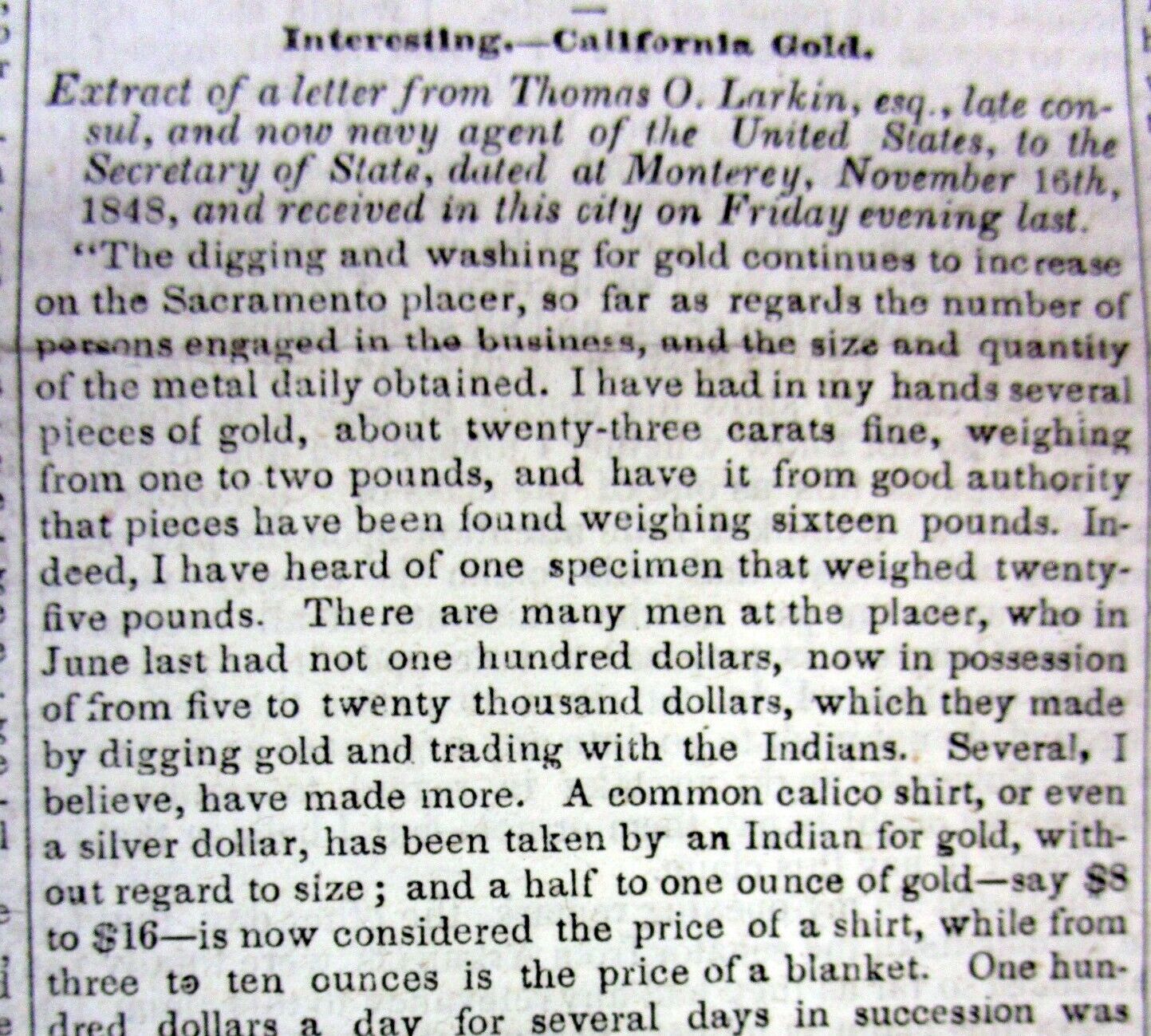
When you click on links to various merchants on this site and make a purchase, this can result in this site earning a commission. Affiliate programs and affiliations include, but are not limited to, the eBay Partner Network.

2 1849 newspapers GOLD IS DISCOVERED in CALIFORNIA & the CA GOLD RUSH BEGINS:
$45.00
2 1849 newspapers GOLD IS DISCOVERED in CALIFORNIA & the CA GOLD RUSH BEGINS
Lot of two (2) 1849 newspapers GOLD IS DISCOVERED in CALIFORNIA & the CALIFORNIA GOLD RUSH BEGINS- inv # 2P-404 Please visit our store for THOUSANDS MORE HISTORICAL NEWSPAPERS for SALE or at sale SEE PHOTO(s) - Lot of two (2) COMPLETE DC) datedJan 23 and Feb 1, 1849.These 2 original early 1849 newspapers contain front page headings and eyewitness accounts of the DISCOVERY OF GOLD in CALIFORNIA and marking the BEGINNING of the CALIFORNIA GOLD RUSH of 1849. The California Gold Rush was sparked by the discovery of gold nuggets in the Sacramento Valley in early 1848 and was arguably one of the most significant events to shape American history during the first half of the 19th century. As news spread of the discovery, thousands of prospective gold miners traveled by sea or over land to San Francisco and the surrounding area; by the end of 1849, the non-native population of the California territory was some 100,000 (compared with the pre-1848 figure of less than 1,000). A total of $2 billion worth of precious metal was extracted from the area during the Gold Rush, which peaked in 1852.
The California gold rush (1848–1855) was a gold rush that began on January 24, 1848, when gold was found by James W. Marshall at Sutter\'s Mill in Coloma, California. The news of gold brought approximately 300,000 people to California from the rest of the United States and abroad. The sudden influx of gold into the money supply reinvigorated the American economy; the sudden population increase allowed California to go rapidly to statehood in the Compromise of 1850. The Gold Rush had severe effects on Native Californians and accelerated the Native American population\'s decline from disease, starvation, and the California genocide.
The effects of the Gold Rush were substantial. Whole indigenous societies were attacked and pushed off their lands by the gold-seekers, called \"forty-niners\" (referring to 1849, the peak year for Gold Rush immigration). Outside of California, the first to arrive were from Oregon, the Sandwich Islands (Hawaii) and Latin America in late 1848. Of the approximately 300,000 people who came to California during the Gold Rush, about half arrived by sea and half came overland on the California Trail and the Gila River trail; forty-niners often faced substantial hardships on the trip. While most of the newly arrived were Americans, the gold rush attracted thousands from Latin America, Europe, Australia and China. Agriculture and ranching expanded throughout the state to meet the needs of the settlers. San Francisco grew from a small settlement of about 200 residents in 1846 to a boomtown of about 36,000 by 1852. Roads, churches, schools and other towns were built throughout California. In 1849 a state constitution was written. The new constitution was adopted by referendum vote; the future state\'s interim first governor and legislature were chosen. In September 1850, California became a state.
At the beginning of the Gold Rush, there was no law regarding property rights in the goldfields and a system of \"staking claims\" was developed. Prospectors retrieved the gold from streams and riverbeds using simple techniques, such as panning. Although mining caused environmental harm, more sophisticated methods of gold recovery were developed and later adopted around the world. New methods of transportation developed as steamships came into regular service. By 1869, railroads were built from California to the eastern United States. At its peak, technological advances reached a point where significant financing was required, increasing the proportion of gold companies to individual miners. Gold worth tens of billions of today\'s US dollars was recovered, which led to great wealth for a few, though many who participated in the California gold rush earned little more than they had started with.
On January 24, 1848, James Wilson Marshall, a carpenter originally from New Jersey, found flakes of gold in the American River at the base of the Sierra Nevada Mountains near Coloma, California.
At the time, Marshall was working to build a water-powered sawmill owned by John Sutter, a German-born Swiss citizen and founder of a colony of Nueva Helvetia (New Switzerland, which would later become the city of Sacramento). As Marshall later recalled of his historic discovery: “It made my heart thump, for I was certain it was gold.”
Days after Marshall’s discovery at Sutter’s Mill, the Treaty of Guadalupe Hidalgo was signed, ending the Mexican-American War and leaving California in the hands of the United States—a remarkable twist of fate with important ramifications for an America eager for westward expansion.
At the time, the population of the territory consisted of 6,500 Californios (people of Spanish or Mexican descent); 700 foreigners (primarily Americans); and 150,000 Native Americans (barely half the number that had been there when Spanish settlers arrived in 1769).
Though Marshall and Sutter tried to keep news of the discovery under wraps, word got out, and by mid-March at least one newspaper was reporting that large quantities of gold were being turned up at Sutter’s Mill. Though the initial reaction in San Francisco was disbelief, storekeeper Sam Brannan set off a frenzy when he paraded through town displaying a vial of gold obtained from Sutter’s Creek.
By mid-June, shops and businesses stood empty, as some three-quarters of the male population of San Francisco had abandoned the city for the gold mines, and the number of miners in the area ballooned to some 4,000 by August.
As news reports—many wildly overblown—of the easy fortunes being made in California spread worldwide, some of the first migrants to arrive were those from lands accessible by boat, such as Oregon, the Sandwich Islands (now Hawaii), Mexico, Chile, Peru and China.
On January 24, 1848, gold was discovered at Sutter’s Mill in Northern California. Get the facts on the rush for gold that followed.
When the news reached the East Coast, press reports were initially skeptical. Gold fever kicked off nationwide in earnest, however, after December 1848, when President James K. Polk announced the positive results of a report made by Colonel Richard Mason, California’s military governor, in his inaugural address.
As Polk wrote, “The accounts of abundance of gold are of such an extraordinary character as would scarcely command belief were they not corroborated by the authentic reports of officers in the public service.”
Throughout 1849, people around the United States (mostly men) with gold fever borrowed money, mortgaged their property or spent their life savings to make the arduous journey to California. In pursuit of the kind of wealth they had never dreamed of, they left their families and hometowns. In turn, women left behind took on new responsibilities such as running farms or businesses and caring for their children alone.
Thousands of would-be gold miners, known as 49ers for the year they arrived, traveled overland across the mountains or by sea, sailing to Panama or even around Cape Horn, the southernmost point of South America.
By the end of the year, the non-native population of California was estimated at 100,000, (as compared with 20,000 at the end of 1848 and around 800 in March 1848). To accommodate the needs of the 49ers, gold mining towns had sprung up all over the region, complete with shops, saloons, brothels and other businesses seeking to make their own Gold Rush fortune.
The overcrowded chaos of the mining camps and towns grew ever more lawless, including rampant banditry, gambling, alcoholism, prostitution and violence. San Francisco, for its part, developed a bustling economy and became the central metropolis of the new frontier. Very good condition. This listing includes the2 complete entire original newspapers, NOT just a clipping or a page of them. STEPHEN A. GOLDMAN HISTORICAL NEWSPAPERS stands behind all of the items that we sell with a no questions asked, money back guarantee. Every item we sell is an original newspaper printed on the date indicated at the beginning of its description. U.S. buyers paypriority mail postage which includes waterproof plastic and a heavy cardboard flat to protect the purchased itemfrom damage in the mail. Uponrequest by the buyer, we can ship by USPS Media Mail to reduce postage cost; however, please be aware that USPS Media Mailcanbe very slow in its time of transit to the buyer.International postage is quoted when we are informed as to where the package is to be sent. We do combine postage (to reduce postage costs) for multiple purchases sent in the same package. We list thousands of rare newspapers with dates from 1570 through 2004 on each week. This is truly SIX CENTURIES OF HISTORY that YOU CAN OWN! Stephen A. Goldman Historical Newspapers has been in the business of buying and selling historical newspapers for over 50 years. Dr. Goldman is a consultant to the Freedom Forum Newseum and a member of the American Antiquarian Society. You can buy with confidence from us, knowing that we stand behind all of our historical items with a 100% money back guarantee. Let our 50+ years of experience work for YOU ! We have hundreds of thousands of historical newspapers (and their very early precursors) for sale.
Stephen A. Goldman Historical Newspapershas been in the business of buying and selling historical newspapers for over 50 years. We are located in the charming Maryland Eastern Shore town of OXFORD, Maryland.
Dr. Goldman is a consultant to the Freedom Forum Newseum and a member of the American Antiquarian Society. You can buy with confidence from us, knowing that we stand behind all of our historical items with a 100% money back guarantee. Let our 50+ years of experience work for YOU ! We have hundreds of thousands of historical newspapers (and their very early precursors) for sale.
We invite customer requestsforhistorical newspapers that are not yetlocated in our extensive listing ofitems. With an inventory of nearlya million historical newspapers (and their early precursors) we arelikely have just the one YOU are searching for.
WE ARE ALSO ACTIVE BUYERS OF HISTORICAL NEWSPAPERS, including large and small personal collections, bound volumes, significant individual issues, or deaccessions from libraries and historical societies. IF YOU WANT TO SELL, WE WANT TO BUY !!!
Powered by SixBit\'s eCommerce Solution

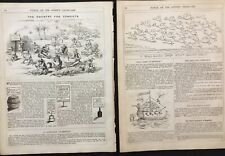
2 California Gold Rush 1849 Wild Goose Chase & Country for Convicts $15.95
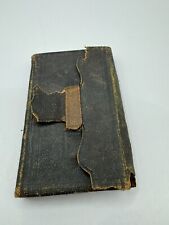
1849 Diary 2x3 Blue Paper Horses And Record Of Expenses Few Entries $26.99

2 1849 newspapers GOLD IS DISCOVERED in CALIFORNIA & the CA GOLD RUSH BEGINS $45.00
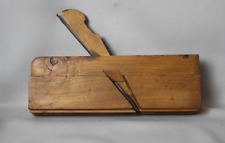
Fine User Antique 1849 Way & Sherman 1/2" Side Bead Moulding Plane Inv##BS06 $35.00

CASE XX Y61066 ~ 1849 CALIFORNIA GOLD RUSH LARGE SWELL CENTER JACK KNIFE ~ 1988 $99.00

2012 Simplicity Sewing Pattern 1849 Womens Knit Tops 2 Sleeves Size 10-20 13646 $18.00

Letter "Premiers Jours 1849" 6 January from Paris, Ceres n°3 sold out: rare tax 2 $214.33
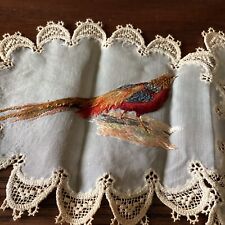
RARE Antique 1840s Edwardian Silk On Silk Figural Monogram LAM Doily $199.00
|